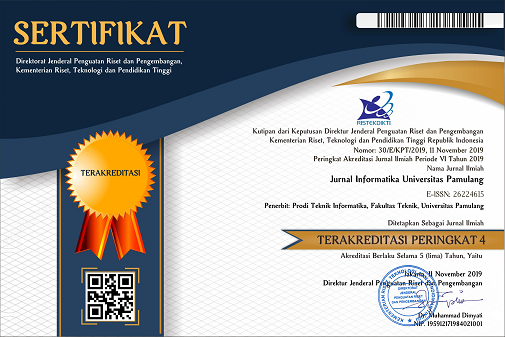Edukasi Pengenalan Huruf Hijaiyah dengan Memanfaatkan Teknologi Augmented Reality
DOI:
https://doi.org/10.32493/informatika.v5i4.8214Keywords:
Hijaiyah, Augmented Reality, Marker, TechnologyAbstract
Augmented Reality (AR) technology provides opportunities for science and engineering. AR also has great opportunities in the world of education, which is to provide and display additional information in the form of 3D objects, video, sound, and text on an object. Smartphone software developers have developed Augmented reality technology that was previously developed on PC devices where this technology utilizes the existing camera on a smartphone. With this situation, AR technology has the opportunity to be used in the development of a media for recognizing hijaiyah letters, so that children will be happier learning because of its attractive appearance and teachers or parents can more easily teach lessons to their children. The way to use it is as follows: first, the user puts a registered and printed marker, second, the smartphone camera identifies (tracking) the marker. If the marker is invalid, the user repeats the identification process. If the marker is valid and identified, the marker will display the hijaiyah letter object in three-dimensional form. Third, users can understand the shape and pronunciation of hijaiyah letters by touching the virtual button on the markerReferences
Ableson, F., & Sen, R. (2011). Android in action. Manning Publications Co.
Adami, Feby Zulham dan Cahyani Budihartanti. 2016. “Penerapan Teknologi Aumneted Reality Pada Media Pembelajaran Sistem Pencernaan Berbasis Android.†Jurnal Teknik Komputer AMIK BSI. 2(1): 123.
Barfield, W. (Ed.). (2015). Fundamentals of wearable computers and augmented reality. CRC press.
Debiyanti, D., Sutrisna, S., Budrio, B., Kamal, A. K., & Yulianti, Y. (2020). Pengujian Black Box pada Perangkat Lunak Sistem Penilaian Mahasiswa Menggunakan Teknik Boundary Value Analysis. Jurnal Informatika Universitas Pamulang, 5(2), 162-166. doi:10.32493/informatika.v5i2.5446
Dipura Atmaja, Nanda Juanda. 2018. “Pengembangan Aplikasi Media Pembelajaran Interaktif 3D tata surya Menggunakan Teknologi Augmented Reality Dengan Android.†Seminar Nasional Sains dan Teknologi. p- ISSN : 2407 – 1846 e-ISSN : 2460 – 8416 Hal: 1-12.
Hanum, W. S., & Saifudin, A. (2019). Rancang Bangun Aplikasi Panduan Pariwisata di Kabupaten Banyuwangi Mobile Berbasis Android. Jurnal Teknologi Sistem Informasi dan Aplikasi, 2(2), 59-65. doi:10.32493/jtsi.v2i2.2798
Haryani, Prita dan Joko Triyono. 2017. “Augmented Reality (AR) Sebagai Teknologi Interaktif Dalam Pengenalan Benda Cagar Budaya Kepada Masyarakat.†Jurnal SIMETRIS. 8(2): 807-812.
Hashimi, S., Komatineni, S., & MacLean, D. (2011). Pro Android 3. Apress.
Idrus, Ali dan Andreo Yudherta. 2016. “Pengembangan Augmented Reality Sebagai Media dalam Meningkatkan Pemahaman Teks Bacaan.†Jurnal Teknologi Pendidikan. 18(3): 140-155.J. K. Author, “Title of chapter in the book,†in Title of His Published Book, xth ed. City of Publisher, Country if not USA: Abbrev. of Publisher, year, ch. x, sec. x, pp. xxx–xxx.
Kurniawan, Didik, Aristoteles dan Muhammad Fathan Kurniawan. 2015. “Augmented Reality (AR) Sebagai Teknologi Interaktif Dalam Pengenalan Benda Cagar Budaya Kepada Masyarakat.†Jurnal Komputasi. 3(2): 136-143.
Mednieks, Z. R., Dornin, L., Meike, G. B., & Nakamura, M. (2012). Programming android. " O'Reilly Media, Inc.".
Muslimin, D. B., Kusmanto, D., Amilia, K. F., Ariffin, M. S., Mardiana, S., & Yulianti, Y. (2020). Pengujian Black Box pada Aplikasi Sistem Informasi Akademik Menggunakan Teknik Equivalence Partitioning. Jurnal Informatika Universitas Pamulang, 5(1), 19-25. doi:10.32493/informatika.v5i1.3778
Ong, S. K., & Nee, A. Y. C. (2013). Virtual and augmented reality applications in manufacturing. Springer Science & Business Media.
Pratala, C. T., Asyer, E. M., Prayudi, I., & Saifudin, A. (2020). Pengujian White Box pada Aplikasi Cash Flow Berbasis Android Menggunakan Teknik Basis Path. Jurnal Informatika Universitas Pamulang, 5(2), 111-119. doi:informatika.v5i2.4713
Yulistina, S. R., Nurmala, T., Supriawan, R. M., Juni, S. H., & Saifudin, A. (2020). Penerapan Teknik Boundary Value Analysis untuk Pengujian Aplikasi Penjualan Menggunakan Metode Black Box Testing. Jurnal Informatika Universitas Pamulang, 5(2), 129-135. doi:10.32493/informatika.v5i2.5366
Downloads
Published
Issue
Section
License
Authors who publish with this journal agree to the following terms:
- Authors retain copyright and grant the journal right of first publication with the work simultaneously licensed under a Creative Commons Attribution-NonCommercial 4.0 International (CC BY-NC 4.0) that allows others to share the work with an acknowledgement of the work's authorship and initial publication in this journal.
- Authors are able to enter into separate, additional contractual arrangements for the non-exclusive distribution of the journal's published version of the work (e.g., post it to an institutional repository or publish it in a book), with an acknowledgement of its initial publication in this journal.
- Authors are permitted and encouraged to post their work online (e.g., in institutional repositories or on their website) prior to and during the submission process, as it can lead to productive exchanges, as well as earlier and greater citation of published work (See The Effect of Open Access).
Jurnal Informatika Universitas Pamulang have CC-BY-NC or an equivalent license as the optimal license for the publication, distribution, use, and reuse of scholarly work.
In developing strategy and setting priorities, Jurnal Informatika Universitas Pamulang recognize that free access is better than priced access, libre access is better than free access, and libre under CC-BY-NC or the equivalent is better than libre under more restrictive open licenses. We should achieve what we can when we can. We should not delay achieving free in order to achieve libre, and we should not stop with free when we can achieve libre.
Jurnal Informatika Universitas Pamulang is licensed under a Creative Commons Attribution-NonCommercial 4.0 International (CC BY-NC 4.0)
YOU ARE FREE TO:
- Share : copy and redistribute the material in any medium or format
- Adapt : remix, transform, and build upon the material for any purpose, even commercially.
- The licensor cannot revoke these freedoms as long as you follow the license terms





